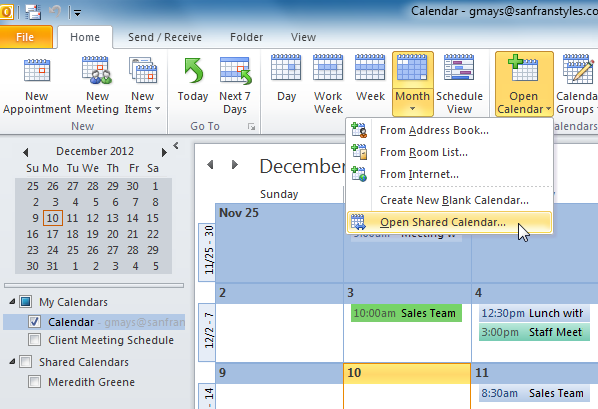
In the dynamic realm of modern work and personal life, effective collaboration is key to success. Microsoft Outlook 2010, a cornerstone in the realm of productivity tools, offers a robust platform for collaborative calendaring. In this extensive guide, we delve deep into the intricacies of collaborating with calendars in Outlook 2010, exploring features, customization options, and best practices to empower users in their journey towards seamless teamwork and efficient scheduling.
I. Introduction to Collaborative Calendaring in Outlook 2010: Fostering Teamwork
A. The Significance of Collaborative Calendaring
Collaborative calendaring in Outlook 2010 goes beyond individual scheduling; it’s a powerful tool for fostering teamwork and ensuring that teams stay synchronized, organized, and aware of each other’s schedules. From coordinating meetings to managing shared events, collaborative calendaring enhances communication and productivity.
II. Shared Calendars in Outlook 2010: Building a Unified Schedule
A. Creating and Sharing Calendars
- Creating a Shared Calendar:
- Navigate to the “Home” tab and select “Share Calendar.”
- Choose a calendar, set permissions, and invite team members.
- Accessing Shared Calendars:
- Team members can access shared calendars through the “Open Calendar” feature under the “Home” tab.
B. Permissions and Access Control
- Configuring Permissions:
- Set detailed permissions for shared calendars based on team roles.
- Right-click on the shared calendar, select “Properties,” and adjust permissions.
- Managing Access Control:
- Control who can view, edit, or delegate activities in the shared calendar.
- Customize access settings under “Home” > “Share Calendar.”
III. Collaborative Event Planning in Outlook 2010
A. Scheduling Meetings and Appointments
- Coordinating Meetings:
- Plan meetings by utilizing the collaborative scheduling features.
- Access the scheduling assistant under the “Meeting” tab.
- Shared Appointment Creation:
- Collaboratively create appointments by using shared calendars.
- Invite team members and schedule events through the shared calendar.
B. Group Scheduling and Resource Booking
- Efficient Group Scheduling:
- Streamline group scheduling by leveraging the “New Meeting” feature.
- Use the scheduling assistant to find suitable time slots for all participants.
- Booking Resources:
- Reserve shared resources such as meeting rooms or equipment.
- Access resource booking options under the “Home” tab.
IV. Collaboration Tools for Outlook 2010 Calendars
A. Integrating Emails and Tasks
- Email Communication from Calendars:
- Seamlessly send emails related to calendar events.
- Right-click on an event and choose “Create Email” to initiate communication.
- Task Integration:
- Link tasks to calendar events for comprehensive project management.
- Access task integration options under the “Task” tab.
B. Real-Time Updates and Notifications
- Real-Time Calendar Updates:
- Stay informed with real-time updates on shared calendars.
- Enable notifications for changes and updates under “File” > “Options” > “Calendar.”
- Meeting Reminders:
- Set reminders for meetings and events to ensure punctuality.
- Adjust reminder settings under the “Meeting” tab.
V. Mobile and Remote Collaboration with Outlook 2010 Calendars
A. Syncing Calendars with Mobile Devices
- Configuring Mobile Sync:
- Enable synchronization of Outlook calendars with mobile devices.
- Configure sync settings and account connections.
B. Remote Access and Online Collaboration
- Utilizing Online Platforms:
- Explore online collaboration platforms for remote access to shared calendars.
- Leverage cloud services and integrations for seamless online collaboration.
VI. Troubleshooting and Common Challenges in Collaborative Calendaring
A. Resolving Sync Issues
- Sync Troubleshooting:
- Address synchronization problems by checking account settings and connectivity.
- Verify sync settings and ensure proper configuration.
B. Overcoming Calendar Overload
- Managing Overloaded Calendars:
- Implement strategies to prevent calendar overload.
- Encourage team members to use shared calendars responsibly.
VII. Future Trends and Outlook 2010 Evolution in Collaborative Calendaring
A. AI-Driven Collaborative Features
- Artificial Intelligence Integration:
- Anticipate advancements in AI-driven collaborative calendaring for intelligent scheduling and proactive team coordination.
B. Cross-Platform Integration
- Unified Calendar Experience:
- Explore unified calendar experiences with cross-platform integrations.
- Adapt to evolving technologies and platforms for seamless collaboration.
VIII. Conclusion: Outlook 2010 – A Catalyst for Team Synergy
Microsoft Outlook 2010, with its collaborative calendaring features, serves as a catalyst for team synergy. By embracing the strategies, features, and best practices outlined in this guide, users can transform Outlook into a dynamic tool that not only facilitates individual scheduling but also fosters seamless teamwork and efficient collaboration.
This comprehensive guide serves as a roadmap for users, from creating shared calendars to troubleshooting common challenges. Whether you’re part of a dynamic team or leading collaborative projects, mastering collaborative calendaring in Outlook 2010 can significantly enhance your team’s productivity, coordination, and communication.
In the ever-evolving landscape of collaborative tools, Microsoft Outlook 2010 remains a reliable ally, evolving to meet the needs of modern teams. By incorporating the insights shared in this guide, users can harness the full potential of Outlook 2010, transforming their collaborative calendaring experience into one of efficiency, organization, and team synergy.